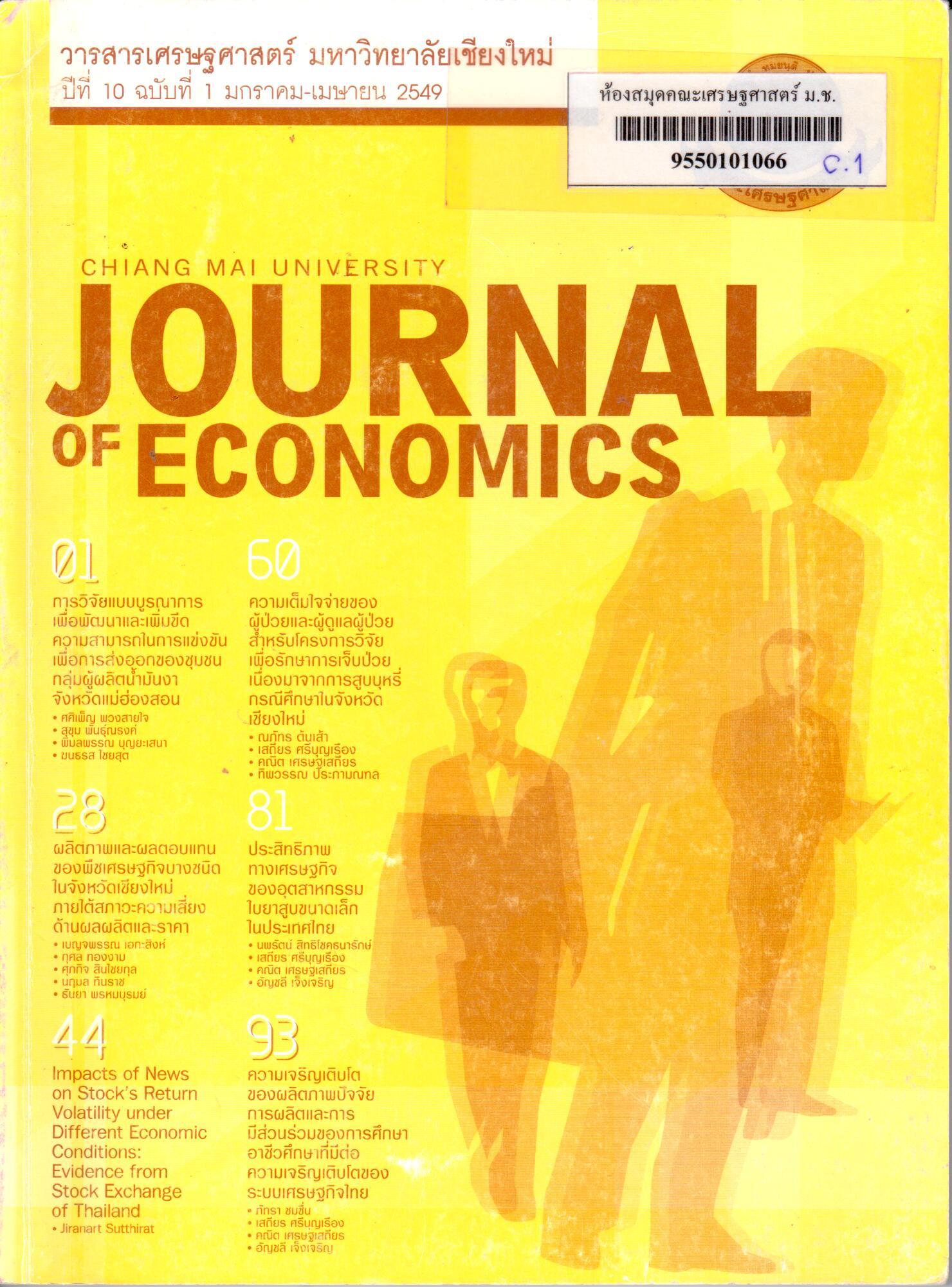ความยั่งยืนทางด้านเศรษฐศาสตร์ในการทำเกษตรกรรมบนพื้นที่สูง และพื้นที่ร่วมของชุมชนในลุ่มน้ำขุนสมุนจังหวัดน่าน
Abstract
บทคัดย่อ
การศึกษาความยั่งยืนทางด้านเศรษฐศาสตร์ในการทำเกษตรกรรมบนพื้นที่สูงและพื้นที่ลุ่มของชุมชนในลุ่มน้ำขุนสมุน จังหวัดน่าน โดยการรวบรวมข้อมูลทางด้านเศรษฐกิจของแต่ละครัวเรือนทั้งในภาคเกษตรและนอกภาคเกษตร และใช้ทั้งข้อมูลปฐมภูมิและทุติยภูมิจากหน่วยงานต่างๆที่เกี่ยวข้อง โดยข้อมูลปฐมภูมิได้จากการสัมภาษณ์ครัวเรือนในสองหมู่บ้าน ด้วยวิธีการสุ่มตัวอย่างอย่างมีระบบ โดยครัวเรือนในพื้นที่ลุ่ม คือ หมู่บ้านกาไส และครัวเรือนที่อยู่พื้นที่สูง คือ หมู่บ้านละเบ้ายา
เมื่อพิจารณาความยั่งยืนทางด้านเศรษฐศาสตร์ในการทำเกษตรกรรมบนพื้นที่สูงและพื้นที่ลุ่ม จะเห็นได้ว่าภายใต้การเผชิญความแปรปรวนของปัจจัยภายนอกทั้งทางด้านราคาปัจจัยการผลิตและผลผลิต รวมถึงผลจากความแปรปรวนของสภาพภูมิอากาศ และภัยธรรมชาติต่างๆ และในด้านปัจจัยภายในของเกษตรกรเอง เช่น การขาดความรู้ในการเพิ่มประสิทธิภาพในการผลิตอย่างถูกวิธี จึงหาหนทางเพิ่มปริมาณผลผลิตโดยการเพิ่มพื้นที่ครอบครอง หรือการใช้ปัจจัยการผลิตต่อพื้นที่เพิ่มขึ้น ซึ่งทำให้ความอุดมสมบูรณ์ของทรัพยากรลดลง จากผลการดังกล่าวพบว่าทางเลือกในการประกอบอาชีพทางการเกษตรของครัวเรือนในพื้นที่สูง เป็นทางเลือกที่ไม่ดีนัก เพราะรายได้ที่เป็นตัวเงินที่เหลืออยู่จากภาคการเกษตรไม่เพียงพอที่จะนำมาใช้จ่ายในการดำรงชีวิตประจำวัน เกษตรกรในพื้นที่สูงจึงต้องไปประกอบอาชีพในทางเลือกอื่น เพื่อให้ได้ตัวเงินมาใช้จ่ายเพียงพอกับภาระดังกล่าว รวมทั้งการหาของป่าซึ่งเป็นอีกทางเลือกหนึ่งที่พื้นที่สูงจะสามารถหารายได้ได้ดีกว่าพื้นที่ลุ่ม
สำหรับในพื้นที่ลุ่ม เพื่อพิจารณาภาพรวมของแหล่งรรายได้ในการปลูกพืช ซึ่งส่วนใหญ่ได้จากพืชไร่ พบว่ายังคงเป็นทางเลือกที่สำคัญ เพราะสามารถหารายได้ได้มากกว่ารายจ่าย อย่างไรก็ตามด้วยรายจ่ายทางด้านการบริโภคที่สูงขึ้นเรื่อยเรื่อยๆ ซึ่งส่วนหนึ่งเป็นผลมาจาก นโยบายของรัฐที่เอื้อต่อการก่อหนี้ เพื่อบริโภคได้ง่ายขึ้น เมื่อพิจารณาร่วมกับการเผชิญปัญหาทางด้านการเกษตรซึ่งไม่แตกต่างจากพื้นที่สูง จึงทำให้คนเดินในพื้นที่ลุ่มต้องหาทางเลือกในการประกอบอาชีพอื่น เพื่อนำรายได้มาจ่ายอย่างเพียงพอ เช่น นอกภาคการเกษตรซึ่งมีแนวโน้มว่าจะเป็นทางเลือกที่สำคัญมากขึ้น เช่นเดียวกับพื้นที่สูง ตราบใดที่รายได้จากภาคการเกษตรยังเพิ่มขึ้นไม่เพียงพอกับรายจ่ายทั้งหมดที่เพิ่มขึ้น ทั้งนี้รายได้ที่จากการหาของป่าก็เป็นอีกทางเลือกหนึ่ง แต่ยังเป็นรายได้ที่หาได้น้อยมากเมื่อเปรียบเทียบกับในพื้นที่สูง เนื่องจากสภาพภูมิอากาศที่ไม่เอื้ออำนวยต่อการหารายได้ดังกล่าว
ดังนั้นเพื่อให้บรรลุถึงความยั่งยืนในการทำเกษตรกรรมในทั้งสองพื้นที่ จึงจำเป็นต้องเร่งแก้ไขปัญหา โดยการแก้ไขปัญหาในระยะสั้น หน่วยงานของทั้งภาครัฐและเอกชนต้องเร่งให้ความรู้โดยการจัดอบรมให้แก่เกษตรกรอย่างต่อเนื่อง เพื่อให้เกิด ความตระหนักถึงการดำรงชีวิตอย่างพอเพียงตามแนวพระราชดำริของพระบาทสมเด็จพระเจ้าอยู่หัว และการผลิตทางการเกษตรที่ไม่ก่อให้เกิดการทำลายทรัพยากรและสิ่งแวดล้อม รวมทั้งหาทางเพิ่มประสิทธิภาพการผลิตต่อหน่วยให้ดีขึ้น โดยยึดหลักความยั่งยืนในการใช้ทรัพยากร สำหรับการแก้ไขปัญหาในระยะยาว ต้องเพิ่มระดับการศึกษาของชุมชนให้มากขึ้น
Abstract
This is the study of the sustainable agricultural economy on a tableland and lowland of the people who live at the basin of Khun-Samun River in Nan Province. The agricultural and non-agricultural economic data were collected from an interview with a random sample in the two villages. The selected village from the lowland was Moo-Baan Ka-Sai. And the tableland was Moo-Baan Labaoyaa.
When the sustainable agricultural economy on the tableland and the low land was considered, under the changing of outside factors such as the processing expense, the product price, the changing of the weather, and natural disaster. And the inside factors such as the lack of knowledge to develop the product quality, the attempting to increase agricultural product by finding more land property, and the chemical using in the agriculture which destroys the rich of natural resources. From the study, choosing to do agriculture was not a good choice for the people who live at a tableland. Because the money income form the agriculture was not enough to pay for family expenditure. The people in the tableland had to decide to do another work, so that they could have enough money to pay for their family expenditure. Finding the non-timber forest products for selling was a better choice for them to earn more money than the people in the low land were.
In the low land, most of the income was from crops plantation that was a good choice for the farm households to gain more income to cover their expenditure. While consumption expenditure is rising that partly because Government’s policy permits people to get loan for the consumption. When the agricultural problems were considered with the outside and the inside factors. The people in these two villages did not have the different problems. Therefore, the people in the lowland had to find another occupation so that they could have more income to cover the expenditures. A off-farm employment can be another essential choice for the people in the tableland can. As long as the income from agriculture does increase until it is enough for the high expenditure. Selling non-timber forest products can be another choice for the people in the lowland, but the income their gain was less than the people in the tableland were. Because of the geography of the lowland does not permit thepeople in lowland to have enough non-timber forest products for selling.
Therefore, to help the farm households in these two villages to have a sustainable agricultural economy for them to live their lives, the agricultural problems are needed to be solved. For the short-term problem solving, the government and the involved private organizations need to inform the farm households to do the diversified agriculture, so that they can live their lives in a sufficiency economy in a responding to the King royal remark. The farm households should be educated to do the agricultural processing which does not destroy natural resources and environment, and improve the agricultural product quality per unit by using the natural resources effectively. For long-term problem solving, the people in the communities should have a higher education.Downloads
Issue
Section
License
All opinions and contents in the CMJE are the responsibility of the author(s). Chiang Mai University Journal of Economics reserves the copyright for all published materials. Papers may not be reproduced in any form without the written permission from Chiang Mai University Journal of Economics.
ข้อคิดเห็นที่ปรากฏและแสดงในเนื้อหาบทความต่างๆในวารสารเศรษฐศาสตร์มหาวิทยาลัยเชียงใหม่ ถือเป็นความเห็นและความรับผิดชอบโดยตรงของผู้เขียนบทความนั้นๆ มิใช่เป็นความเห็นและความรับผิดชอบใดๆของวารสารเศรษฐศาสตร์ มหาวิทยาลัยเชียงใหม่
บทความ เนื้อหา และข้อมูล ฯลฯ ในวารสารเศรษฐศาสตร์มหาวิทยาลัยเชียงใหม่ ถือเป็นลิขสิทธิ์เฉพาะของคณะเศรษฐศาสตร์มหาวิทยาลัยเชียงใหม่ หากบุคคลหรือหน่วยงานใดต้องการนำทั้งหมดหรือส่วนหนึ่งส่วนใดไปเผยแพร่ต่อหรือเพื่อกระทำการใดๆ จะต้องได้รับอนุญาตเป็นลายลักษณ์อักษร จากวารสารเศรษฐศาสตร์ มหาวิทยาลัยเชียงใหม่






